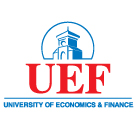Fall Study Program: UEFers explore traditional customs and impressive destinations
Following the series of international short term programs organized by UEF International Institute in coordination with Kobe International University, UEFers gained even more exciting experiences in Japan. The students had the opportunity to visit many renowned cultural places and participate in some traditional courses of the land of the rising sun.
Explore traditional rituals and participate in English class with Japanese people
.jpg)
.jpg)
UEF students learned about Japanese greeting rituals
.jpg)
UEF students learned about Japanese greeting rituals
.jpg)
.jpg)
.jpg)
.jpg)
The calligraphy class took place on that same day
After lunch, the students continued on to the tea ceremony lesson after participating in these two sessions. In Japanese culture, the tea ceremony is an artistic way of enjoying tea that dates back to the 12th century. The Japanese people blended the pleasure of tea drinking with the Zen spirit of Buddhism to enhance the art of tea appreciation, promoting it as an indispensable art when discussing Japan.
.jpg)
.jpg)
The students practiced making tea alongside the Japanese instructor
Concluding the lessons on rituals and traditional culture, the students moved on to participate in an English class - a form of practical class at Kobe International University, with their Japanese lecturer, Dr. Hatanaka. With the advantages of bilingual and international cooperation programs , UEFers comfortably engaged in collaboration with Japanese students.
.jpg)
.jpg)
.jpg)
An enjoyable and interactive English class was delivered by the Japanese teacher
Kyoto field trip with plenty of helpful knowledge
Guided by Ms. Hatakana (a staff of Kobe International University), UEFers and international friends explored the ancient city of Kyoto. After traveling for more than an hour by train, they arrived at the scenic spot and then went around Gion, Kiyomizudera, and Ginkakuji. Crossing the Shijo-ohashi Bridge, the Kennin-ji Temple appeared amidst the pedestrian pathways.
.jpg)
.jpg)
.jpg)
.jpg)
UEFers traveled by train to visit Kennin-ji Temple
After visiting the temple, the students rested and had lunch at a local traditional restaurant specializing in Bento called Kaiseki Restaurant. Bento is a Japanese term for a packed meal, typically meant for lunch. Rice or noodles, together with meat or fish are typically found in traditional bento boxes with pickled or cooked vegetables are sometimes included as well. Bento can be sophisticatedly created in a style called "kyaraben" ("character bento"), often decorated to resemble famous characters from Japanese anime, manga, or video games.
After lunch, the UEFers continued to visit some shrines and historical sites in the area. Kiyomizu-dera Temple - a Buddhist temple situated in eastern Kyoto, is the most prominent of these temples and conveniently situated on the highest area in the city. Kiyomizu-dera is. As an UNESCO World Heritage Site, the temple is a component of the old Kyoto historic monuments (Kyoto, Uji, and Otsu).
.jpg)
.jpg)
.jpg)
UEFers visited the renowned Kiyomizu-dera Temple
Furthermore, the students also had the opportunity to visit other famous locations such as the Yasaka Pagoda and the Yasaka-jinja Shrine. Yasaka Pagoda, also known as the Yasaka Tower and Yasaka-no-to, is a Buddhist temple located in Higashiyama-ku. It is the five-storey pagoda, the last standing architectural structure from a temple complex dating back to the 6th century which is known as the Hōkan-ji Temple.
.jpg)
.jpg)
UEFers moved to visit the Yasaka Pagoda
.jpg)
UEFers moved to visit the Yasaka Pagoda
Yasaka-jinja Shrine, formerly known as Gion-jinja Shrine, is a Shinto shrine located in Gion, Kyoto. Situated at the eastern end of Shijō-dōri (Main Avenue No. 4), the shrine comprises several buildings, gates, the main hall, and a stage.
.jpg)
.jpg)
UEFers visited Yasaka-jinja Shrine Temple
At the end of the trip, UEFers enjoyed the beauty of the sunset in Kyoto before returning to the hotel.
Check-in Osaka with impressive culinary and entertainment destinations
OCTOBER 22 -On the fifth day of the journey, UEF and Taiwanese students toured Osaka, accompanied by Ms. Wakasugi (a staff of Kobe International University).After more than 30 minutes traveling by train, the group arrived at thẻ Cup Noodle Museum.
.jpg)
.jpg)
UEFers arrived at Cup Noodle Museum
The Cup Noodles Museum Osaka Ikeda was established in 1999 to showcase the history of instant noodles, emphasizing the significance of innovation and exploration in various inventive stages. At the museum, students not only learn about the development, history, and manufacturing processes of instant noodles but also have opportunities to create their own cup noodles with soup and optional ingredients at the "My Cup Noodles Factory", as well as create handmade chicken ramen at the "Handmade Chicken Ramen Hands-On Workshop”.
.jpg)
.jpg)
.jpg)
.jpg)
UEFers visited and experienced making cup noodles at the Cup Noodles Museum
Concluding the museum visit, UEFers headed to the Osaka Botejyu Restaurant. This place is a famous eatery known for its Japanese-style savory pancakes (Okonomiyaki). At the restaurant, UEFers also had hands-on experience in making Japanese-style Okonomiyaki, one of the local traditional dishes.
Additionally, UEF students had the opportunity to visit and go shopping at Namba Station. The weather in Osaka at that time was getting cooler with transformative greens as it was the autumn season in Japan. Students could find numerous shops, restaurants, and well-known services here. Namba Station is directly connected to the train station and offers everything from information centers to shopping, dining, and various services, helping students fully enjoy their time in Osaka.
.jpg)
.jpg)
UEFers enjoyed Japanese-style savory pancakes at the Osaka Botejyu Restaurant
.jpg)
.jpg)
Students experienced the shopping atmosphere in the Namba Station area
.jpg)
Leaving Osaka, UEFers returned to the hotel after a long day of exploration
Through this trip, the students had the opportunity to experience and gain knowledge from the advanced culture and education of the land of the rising sun. With this meaningful exchange program from UEF International Institute, the students will confidently become global citizens in the future. This trip will also create unforgettable memories in their "aboard journey diary."
Quang Huy
Photos: UEF International Institute









